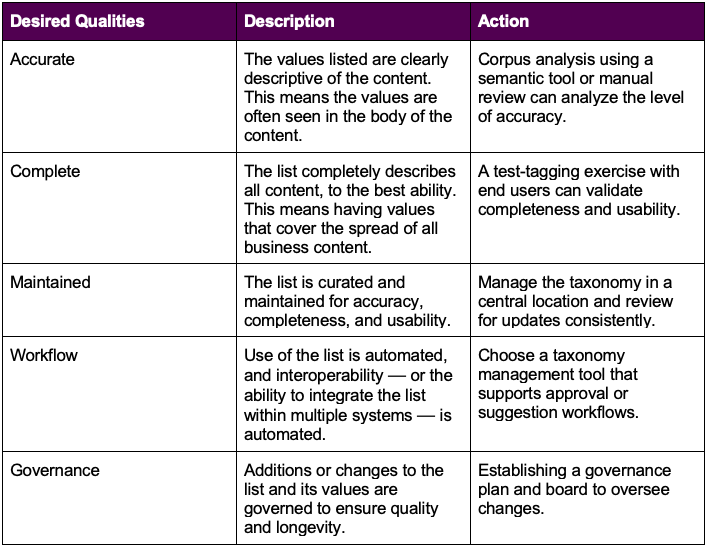One of the first steps of a taxonomy design effort is to gather any previous taxonomies that may exist within the business, as well as sample content, search logs, and pre-existing information about these taxonomies’ content or systems. At EK, we use these gatherings work to ensure that we’re leveraging the best of what an organization already has. While existing taxonomies might not be known as “taxonomies,” or might only be loosely referred to as such, any controlled list of values will greatly inform the overall taxonomy design. In other words, “that which we call a rose / by any other name would smell as sweet.”
Following a review of existing lists or taxonomies, businesses will often find the same type of list, such as “document type,” in multiple systems. These lists may vary greatly or just slightly, so how can we determine which to use as the standard? Two approaches exist at this juncture.
What we typically recommend is to commence a taxonomy design effort by gathering all of those lists, conducting a hybrid (bottom-up and top-down) analysis, and rationalizing these lists into a single, cohesive list. Unfortunately, business users and even some taxonomists take the easier path of selecting to work with only one of their existing lists ignoring the value that other lists might bring to the table. We try to dissuade organizations from this path, as it is rare that any single existing list has all the qualities needed to serve in place of a well-designed taxonomy.
Depending on the circumstances and quality, the temporary use of an existing list can be justified, but only if that list encapsulates the qualities of a true golden source. A golden source, or a single source of truth, refers to having one source of data that all other locations and repositories can refer or point to, rather than having and maintaining the same list in multiple places. Highly regarded in data and information management, this single version of truth concept ensures standardization and the breakdown of information silos. A golden list is just one of the many types of data or information that can been seen as a golden source.
Even so, how do we know we can trust one list as a comprehensive standard unless we have designed it to be such? Some of the primary qualities or characteristics one should seek when selecting an existing list as a golden source are defined in this table along with descriptions and ways to reach or ensure qualities are met:
If these factors aren’t true for the existing list, it is time to commence the effort to design a taxonomy that can be deemed ‘golden’ and will supply other systems with the correct value lists. Since we have the existing lists as inputs, we are not beginning the taxonomy design from scratch. Instead, we can work to consolidate or align the lists, keeping the strongest components of each. In order to do this, we want to keep the following items in mind:
- Due to industry, or even company specific jargon, we will need to enlist the help of Subject Matter Experts (SMEs) to decipher terms and agree upon common vocabulary;
- Even though we are consolidating lists, the resulting taxonomy should still be evaluated for completeness in comparison to the content we want to describe; and
- We will need to plan for the continued inputs of multiple sources over the life of the taxonomy by establishing governance roles and processes.
- We will seek to assess the alignment or “sameness” of all terms in the list, at each level of the list, in order to ensure the design is cohesive and balanced.
Finally, it is important to store and manage the taxonomy in a central location where it can be accessed and integrated with various content repositories and search engines to enable the findability of content. Ensuring the taxonomy is stored centrally and is easily accessible can also reduce the recurrence of new, competing lists being developed. The use of a taxonomy management tool, whether it is SharePoint Term Store or a semantic tool like PoolParty or Smartlogic Semaphore, and a strong governance and communication plan is the best way to ensure an interoperable golden source that is recognized and used throughout the enterprise.
EK can help you to design and implement a business taxonomy that can be used as the golden source for enterprise repositories and content through our proven Business Taxonomy Design Methodology. A business taxonomy is designed for usability and findability of content and allows the flexibility to describe content regardless of organizational silos. The business taxonomy can also be leveraged as golden source data to support reporting and navigation.
If this something you’d like to speak with the experts at EK about, contact us at info@enterprise-knowledge.com.

